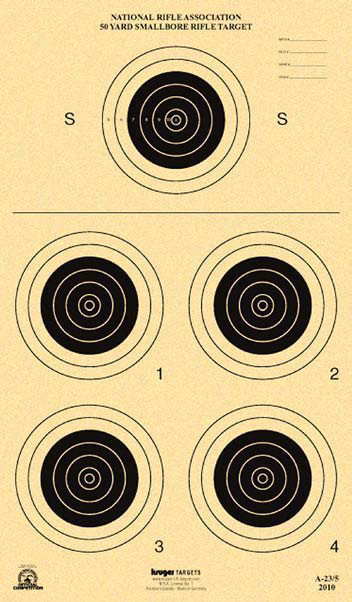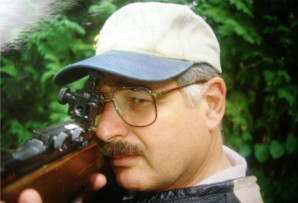

A short history lesson is needed to understand why shooting in the United States developed as it has and not in lockstep with Europe. Although it is certain that contests of hitting an object at a distance with a rock, spear, or sling date back to prehistoric times (the story of David and Goliath, for example), competitive target shooting, as we know it, has its roots in medieval Europe.
Perhaps the first well known early marksman was the legendary Swiss patriot, William Tell, who was imprisoned by the Austrian governor and won his freedom by shooting an apple from his son’s head. His deeds fi rst inspired shooters and later composer Gioachino Rossini. The music of Rossini’s William Tell Overture’s “March of the Swiss Soldiers” became the theme for another noted marksman, The Lone Ranger. So close are they tied that it is said the mark of a true intellectual is a person who can listen to the William Tell Overture and not think of the Masked Man.
... the urbanization of the United States in the middle 1800s diluted the marksmanship skills of the populace, a fact well evident by the poor shooting skills of vast numbers of Union troops during the Civil War.
Skill with a longbow or crossbow was an important military asset, much valued and encouraged by European monarchs. So much so that in the late 13th Century, King Edward I (known as “Longshanks”), in order to preserve the skill of his bowmen, went so far as to ban all sports but archery on Sundays. At about the same time, competitive shooting was becoming popular enough to see the birth, in Germany, of Schützenvereins—shooting clubs that engaged in organized marksmanship events.
By the time Europeans settled the New World, firearms were replacing the bow as the principal arm for military and recreational use. The early settlers came from a society where firearms and hunting were the province of the aristocracy and its military, rather than the peasants who worked the land for them. Soldiers, such as Plymouth Colony’s Captain Miles Standish and Virginia’s Captain John Smith were essential to the defense of the infant colonies. They trained the colonists regularly with firearms so that they would become good marksmen. From this early beginning, the tradition of exceptional American marksmanship grew.
As civilization moved westward, so did the skill and competition with firearms. The Pennsylvania-made “Kentucky Rifle,” in the hands of the likes of Daniel Boone and Davy Crockett, was the main instrument in frontier marksmanship contests called “Rifle Frolics,” which featured turkey or beef shoots. Later, no self-respecting mountain man would dare be found without a Green River knife and a .50-caliber rifle made by Jacob and Samuel Hawken, with which they would shoot at a mark during a trapper’s rendezvous. In these shooting contests, the targets were handmade.
However, the urbanization of the United States in the middle 1800s diluted the marksmanship skills of the populace, a fact well evident by the poor shooting skills of vast numbers of Union troops during the Civil War. The National Rifle Association was formed to reverse that trend and, in 1874, found itself involved in international marksmanship competition against a team from Ireland in which the oldest continuously awarded marksmanship award in the United States—the Leech Cup—made its debut.
... while the British have moved to the metric target, the shooters in the United States have resisted the change, retaining the targets which have been in use since the early 20th Century.
The United States shooting community was strongly influenced by the United Kingdom. When America began its own outdoor smallbore competitive program at the 1919 National Matches, whose Chief Range Officer and Assistant Executive Officer—U.S. Army Captain Edward Cathcart Crossman—called upon Captain E.J.D. Newitt to lend his expertise to the fledgling effort. Newitt, a British citizen and an officer of that nation’s Society of Miniature Rifle Clubs, had extensive experience in mounting the British smallbore championships at Bisley.
Smallbore shooting in the United States, primarily a prone sport until the mid 1950s, is very much aligned with the British model. However, while the British have moved to the metric target, the shooters in the United States have resisted the change, retaining the targets which have been in use since the early 20th Century.
This seeming intransigence on the part of the U.S. shooting community to adopt the more discriminating metric target seems to be based on several factors. The first might be the insulating distance of the Atlantic Ocean which precludes much shoulder-to-shoulder competition with the ISSF-dominated Europeans. A second reason may be that European nations are all within relatively short travel distances and compete among each other regularly, making their shooting communities much more prone (pardon the pun) to agreement on a common target.
The lack of open land and the density of Europe’s population also mean that shooting ranges are, as a rule, limited to short distances and usually walled in for safety reasons. A byproduct of walled ranges is that they offer protection for the shooter and bullet. On the other hand, in the spacious United States, there are many more ranges and most are situated in large open areas; witness Camp Perry. As such, our ranges expose the shooter and the bullet to harsher weather conditions. The shooter, bullet, and targets are often roasted by sun, drenched by rain and, most devastatingly, battered by wind.
... in 2008, a controversial and reactionary move saw the NRA Smallbore Committee eliminate metric targets from the individual and team position and prone team matches at the National Outdoor Smallbore Rifle Championships where they had been a fixture for decades.
A significant segment of shooters in the United States have resisted the change to the smaller metric target and its consequently lower scores. As a result, in 2008, a controversial and reactionary move saw the NRA Smallbore Committee eliminate metric targets from the individual and team position and prone team matches at the National Outdoor Smallbore Rifle Championships where they had been a fixture for decades. One of the stated reasons was that conditions at Perry are not conducive to good scores on the smaller metric target, which was thought to be discouraging attendance. In 2011, a new metric tournament was established to accommodate both communities.
The United States’ most common outdoor smallbore targets, the 50-yard A-23, the 50-meter A-26, and the 100-yard A-25 have now been in use for more than eighty years. Noted shooting historian and frequent SSUSA contributor Paul Nordquist, commenting on the United States’ shooting community’s rejection of international metric targets, notes that, “There may be a tad of irony in that the 50-meter target we use in smallbore prone competition was, until 1958, also the International target.” Perhaps then, in the most traditional of sports in the United States, the real reason we call shooting on “our” targets conventional, is simply the definition of the word: “of long-established design.”

Frequent SSUSA contributor Hap Rocketto was rated a Distinguished Rifleman in 1981. He is one of few who have been a member of both Service Rifle and Smallbore Rifle All National Guard Rifle Teams, where he served as both a coach and a shooter. An NRA Smallbore Distinguished Position Rifleman, he has earned the “Presidents Hundred” honors three times, has been a member of numerous open and National Guard national championship teams, the 2002 Three Position Intermediate Senior National Champion, a member of the 2007 U.S. Championship Indoor Four-Position Championship team, as well as a multiple National Record holder. He is a member of the 1600 Club and has served as adjutant of the U.S. Roberts Team, as well as captain and coach of the U.S. Drew Cup Team. Rocketto was a member of the 1973 and 1985 U.S. silver medal winning Maccabiah Rifle Team and is a member of the Connecticut Shooters Hall of Fame.

































